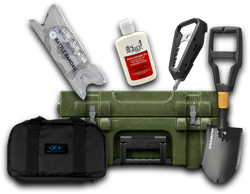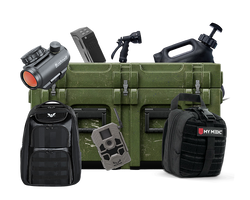
8 Tips for Packing Your Bug Out Bag
Your bug out bag is what will keep you alive when SHTF. It should include all of the necessary gear for you to survive off the grid. While there are many guides for what to keep in your bug out bag, it is also important to understand the best tips for packing your bug out bag essentials so that all of your survival gear is easily accessible and usable when the time comes to fight to survive.
Here are our top 8 tips to keep in mind when packing your bug out bag:
- Have more than one bug out bag. If financially feasible, you should have more than one bug out bag. They should be strategically located so that if you are unable to access your home in an emergency you will still be able to get to your supplies. We recommend two bug out bags – one in your home and another either in your car or in a hidden outdoor location. You do not want to find yourself in a scenario where you are prepared to survive but are unable to do so because you can’t reach your gear. Additionally, your bags should be packed based on your bug out plan. Make a plan before selecting the items to include in your bag because not all gear is needed for every situation.
- Only pack the essentials. Once you have made your personal list of what you think you will need, go through it and start eliminating items. Remember that your bag is designed to keep you alive, not make you comfortable. You should only include the absolute essentials. So, packing a sleeping bag or mattress pad should not be high on your packing list, but first aid kit items should be a priority. The more you carry, the heavier the bag will be, and the slower you will be when on the move. Instead of lugging around water, consider packing water purification tablets. Once you have packed your bag, carry it for a few miles on hilly terrain and see how reasonable the weight feels. We recommend shooting for 20-25 pounds maximum. Having a bug out bag the size of your body weight would be more of a hinderance during an emergency situation.
- Leave room. Don’t pack your bag so full that the seams are bursting. You’ll come across items as you travel that you will want to bring with you. Leave some room in your bag so that you can capitalize on gear that you find along your bug out route.
- Keep everything up-to-date. The same rules apply to your bug out bags as to your home stockpile. You wouldn’t pack a cellar full of food, medicines, etc. and never replace it as it expires, so don’t let your bug out bag stock go bad either. Keep track of what you have and when it will need to be replaced so that everything is still fresh when it comes time to use it. If you decide to pack food, make sure it has a longer shelf life.
- Always have backups. When SHTF, life will be moving quickly. Items you need will inevitably go missing, break, or malfunction. Make sure you have backups of the most important survival items in your bug out bag (i.e. an extra knife, multi tool, spare batteries, matches, flashlight, aid kits, etc.).
- Choose dual-function items. Space is precious in your bug out bag, and like we mentioned above, you want to have backups of the essentials. The best way to ensure you have backups while saving space is to select dual-function items. Rain gear can be used to protect you from the rain as well as shelter in any weather. Including a couple of multi-tools is always a good idea, and a survival knife can protect you and be used to gather supplies in the wild. Be creative.
- Pack the weight strategically. Pack the heaviest items at the base of the survival bag and closest to your back. The closer the weight is to your spine, the easier it is to carry and the less stress it will put on your body. It may not seem to make a difference when carrying the bag for 5-10 minutes, but when you are hiking all day with it on your back it can be a game-changer.
- Pack by urgency. Think about the things you will need most often in your go bag. Put them in the bag last so that they are on top and easily accessible. If your bag has different compartments and pockets, pack your most-used items in the easiest to access spaces. Make sure things like a first aid kit are easily accessible for a survival situation. This will save you valuable time by preventing you from having to unpack and repack your bag continuously.
The strategy of packing your survival kit is almost as important as what goes in it in terms of supplies. If you overpack, pack the wrong items, or pack your everyday use items in hard-to-reach spaces, you are much less likely to overcome a SHTF situation. You never know when a natural disaster or global crisis with occur. Prepare ahead of time so that you will be as efficient and successful as possible.
Share this article







